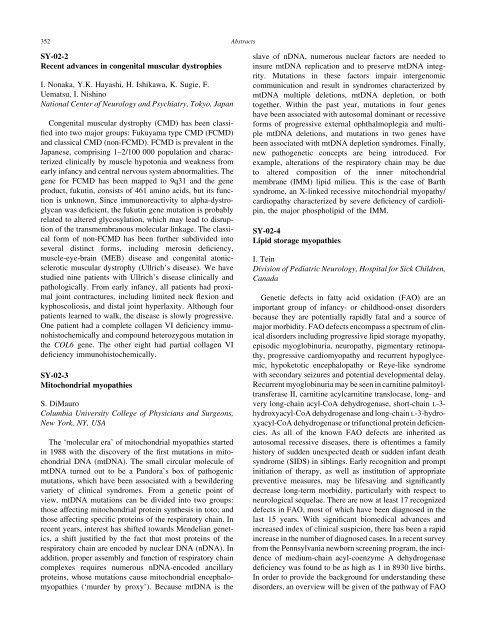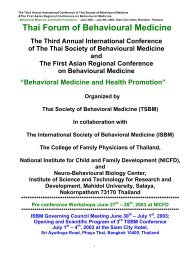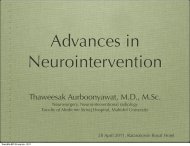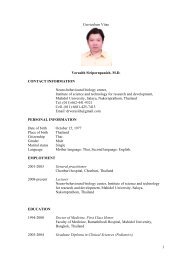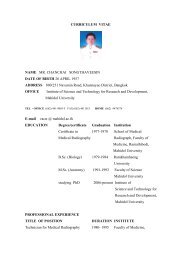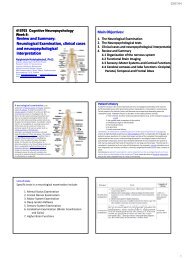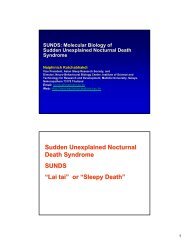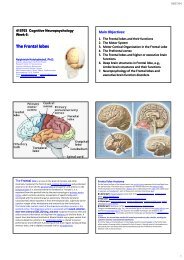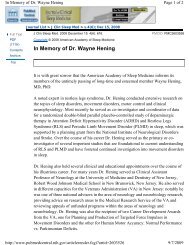PDF File - Mahidol University
PDF File - Mahidol University
PDF File - Mahidol University
Create successful ePaper yourself
Turn your PDF publications into a flip-book with our unique Google optimized e-Paper software.
352<br />
Abstracts<br />
SY-02-2<br />
Recent advances in congenital muscular dystrophies<br />
I. Nonaka, Y.K. Hayashi, H. Ishikawa, K. Sugie, F.<br />
Uematsu, I. Nishino<br />
National Center of Neurology and Psychiatry, Tokyo, Japan<br />
Congenital muscular dystrophy (CMD) has been classified<br />
into two major groups: Fukuyama type CMD (FCMD)<br />
and classical CMD (non-FCMD). FCMD is prevalent in the<br />
Japanese, comprising 1–2/100 000 population and characterized<br />
clinically by muscle hypotonia and weakness from<br />
early infancy and central nervous system abnormalities. The<br />
gene for FCMD has been mapped to 9q31 and the gene<br />
product, fukutin, consists of 461 amino acids, but its function<br />
is unknown. Since immunoreactivity to alpha-dystroglycan<br />
was deficient, the fukutin gene mutation is probably<br />
related to altered glycosylation, which may lead to disruption<br />
of the transmembranous molecular linkage. The classical<br />
form of non-FCMD has been further subdivided into<br />
several distinct forms, including merosin deficiency,<br />
muscle-eye-brain (MEB) disease and congenital atonicsclerotic<br />
muscular dystrophy (Ullrich’s disease). We have<br />
studied nine patients with Ullrich’s disease clinically and<br />
pathologically. From early infancy, all patients had proximal<br />
joint contractures, including limited neck flexion and<br />
kyphoscoliosis, and distal joint hyperlaxity. Although four<br />
patients learned to walk, the disease is slowly progressive.<br />
One patient had a complete collagen VI deficiency immunohistochemically<br />
and compound heterozygous mutation in<br />
the COL6 gene. The other eight had partial collagen VI<br />
deficiency immunohistochemically.<br />
SY-02-3<br />
Mitochondrial myopathies<br />
S. DiMauro<br />
Columbia <strong>University</strong> College of Physicians and Surgeons,<br />
New York, NY, USA<br />
The ‘molecular era’ of mitochondrial myopathies started<br />
in 1988 with the discovery of the first mutations in mitochondrial<br />
DNA (mtDNA). The small circular molecule of<br />
mtDNA turned out to be a Pandora’s box of pathogenic<br />
mutations, which have been associated with a bewildering<br />
variety of clinical syndromes. From a genetic point of<br />
view, mtDNA mutations can be divided into two groups:<br />
those affecting mitochondrial protein synthesis in toto; and<br />
those affecting specific proteins of the respiratory chain. In<br />
recent years, interest has shifted towards Mendelian genetics,<br />
a shift justified by the fact that most proteins of the<br />
respiratory chain are encoded by nuclear DNA (nDNA). In<br />
addition, proper assembly and function of respiratory chain<br />
complexes requires numerous nDNA-encoded ancillary<br />
proteins, whose mutations cause mitochondrial encephalomyopathies<br />
(‘murder by proxy’). Because mtDNA is the<br />
slave of nDNA, numerous nuclear factors are needed to<br />
insure mtDNA replication and to preserve mtDNA integrity.<br />
Mutations in these factors impair intergenomic<br />
communication and result in syndromes characterized by<br />
mtDNA multiple deletions, mtDNA depletion, or both<br />
together. Within the past year, mutations in four genes<br />
have been associated with autosomal dominant or recessive<br />
forms of progressive external ophthalmoplegia and multiple<br />
mtDNA deletions, and mutations in two genes have<br />
been associated with mtDNA depletion syndromes. Finally,<br />
new pathogenetic concepts are being introduced. For<br />
example, alterations of the respiratory chain may be due<br />
to altered composition of the inner mitochondrial<br />
membrane (IMM) lipid milieu. This is the case of Barth<br />
syndrome, an X-linked recessive mitochondrial myopathy/<br />
cardiopathy characterized by severe deficiency of cardiolipin,<br />
the major phospholipid of the IMM.<br />
SY-02-4<br />
Lipid storage myopathies<br />
I. Tein<br />
Division of Pediatric Neurology, Hospital for Sick Children,<br />
Canada<br />
Genetic defects in fatty acid oxidation (FAO) are an<br />
important group of infancy- or childhood-onset disorders<br />
because they are potentially rapidly fatal and a source of<br />
major morbidity. FAO defects encompass a spectrum of clinical<br />
disorders including progressive lipid storage myopathy,<br />
episodic myoglobinuria, neuropathy, pigmentary retinopathy,<br />
progressive cardiomyopathy and recurrent hypoglycemic,<br />
hypoketotic encephalopathy or Reye-like syndrome<br />
with secondary seizures and potential developmental delay.<br />
Recurrent myoglobinuria may be seen in carnitine palmitoyltransferase<br />
II, carnitine acylcarnitine translocase, long- and<br />
very long-chain acyl-CoA dehydrogenase, short-chain l-3-<br />
hydroxyacyl-CoA dehydrogenase and long-chain l-3-hydroxyacyl-CoA<br />
dehydrogenase or trifunctional protein deficiencies.<br />
As all of the known FAO defects are inherited as<br />
autosomal recessive diseases, there is oftentimes a family<br />
history of sudden unexpected death or sudden infant death<br />
syndrome (SIDS) in siblings. Early recognition and prompt<br />
initiation of therapy, as well as institution of appropriate<br />
preventive measures, may be lifesaving and significantly<br />
decrease long-term morbidity, particularly with respect to<br />
neurological sequelae. There are now at least 17 recognized<br />
defects in FAO, most of which have been diagnosed in the<br />
last 15 years. With significant biomedical advances and<br />
increased index of clinical suspicion, there has been a rapid<br />
increase in the number of diagnosed cases. In a recent survey<br />
from the Pennsylvania newborn screening program, the incidence<br />
of medium-chain acyl-coenzyme A dehydrogenase<br />
deficiency was found to be as high as 1 in 8930 live births.<br />
In order to provide the background for understanding these<br />
disorders, an overview will be given of the pathway of FAO


